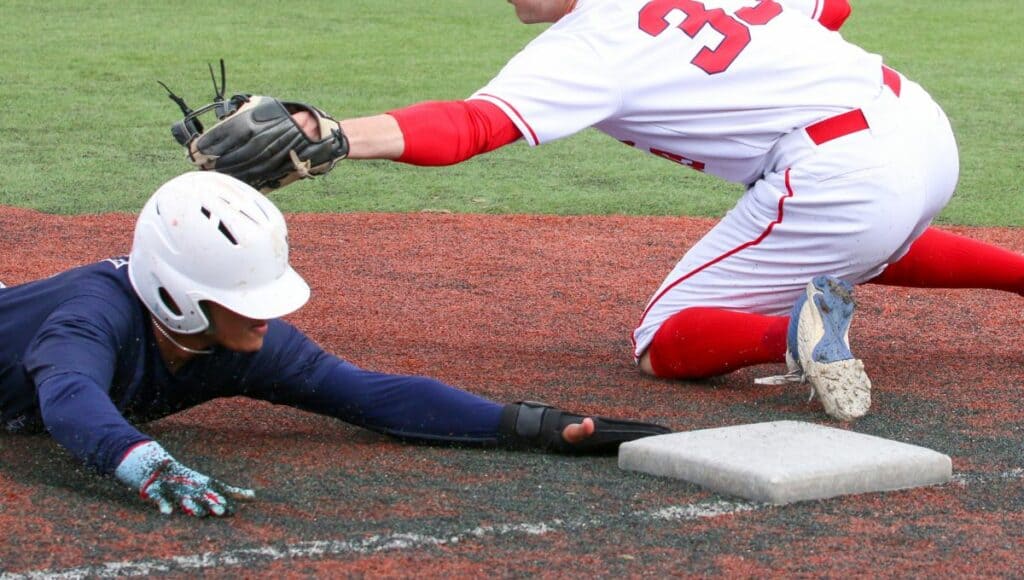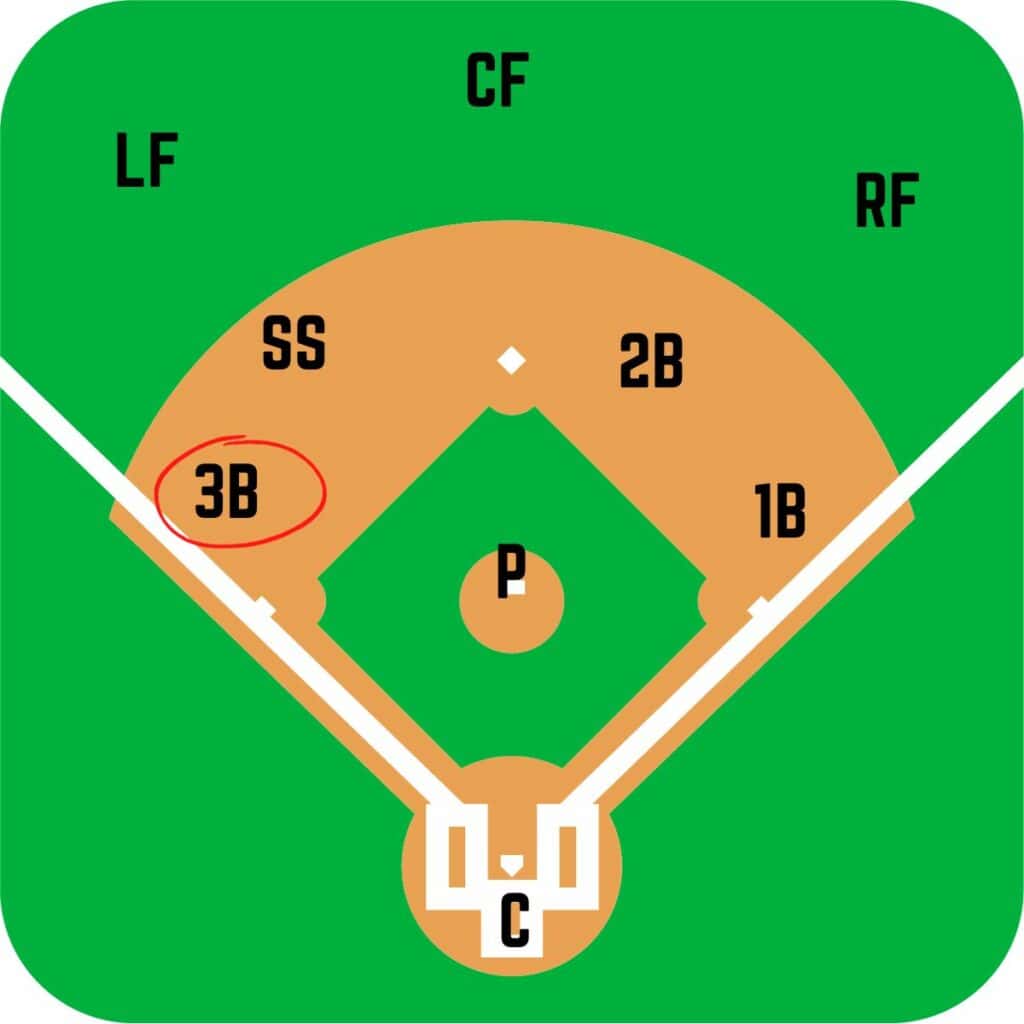Third Base Position in Baseball: Defining the Hot Corner’s Role
In the game of baseball, the third base position, also known as the “hot corner,” is one of the most challenging and pivotal spots on the field. Occupying the left corner of the infield, third basemen are often involved in some of the quickest reaction plays, requiring not only agility and precision but also a keen sense of anticipation. The close proximity to the batter makes it crucial for players at this position to have quick reflexes and a strong arm, as they often handle hard-hit ground balls and must make long, accurate throws across the diamond to first base.

Your responsibilities as a third baseman extend beyond fielding; you’re also integral to the team’s defense strategy. Whether it’s guarding the line against extra-base hits, charging bunt attempts, or covering your base during steal attempts, a third baseman’s role is diverse. Mastery of this position can greatly influence the game’s outcome by shutting down opponents’ scoring opportunities. To excel at third base, you must develop a comprehensive skill set, including footwork, hand-eye coordination, and a deep understanding of in-game strategy.
Key Takeaways
- Third base is key for defense, requiring quick reactions and strong throws.
- A third baseman’s responsibilities are varied, from guarding lines to fielding bunts.
- Excelling at third base demands a combination of skills and strategic understanding.
Understanding the Role of the Third Baseman

The third baseman plays a critical role in baseball’s defense, often seen as the anchor of the infield. Your understanding of this position is essential to appreciating the game’s complexities.
Historical Significance of 3rd Base
Historically, third base has been dubbed the “hot corner.” This nickname derives from the tendency for hard-hit balls to travel rapidly toward the third baseman.
In baseball’s early days, you could recognize a shift in the defensive capabilities at third base, as the position evolved to require quick reflexes and a strong arm.
Characteristics of Elite Third Basemen
Elite third basemen distinguish themselves through a combination of attributes. You’ll notice their quick reflexes, necessary to snatch line drives and hard grounders.
In addition, they possess strong throwing arms capable of making the long throw to first base. Their agility and rapid decision-making enable them to charge bunts and make plays on the run successfully.
Athleticism:
- Quick reflexes
- Strong arm
- Agile footwork
Positional Responsibilities
As a third baseman, your primary responsibilities include guarding the third base line, fielding bunts, and turning double plays.
A third baseman must be able to field the ball cleanly and make accurate throws across the diamond.
Your role is crucial in preventing doubles and triples by adeptly handling sharp grounders and line drives.
Defensive Duties:
- Guard the third base line
- Field bunts
- Initiate double plays
- Cover the bag for force plays and steals
Skills and Techniques for Third Base Excellence
Mastering the third base position requires a combination of specific skills and techniques.
Your success at third base hinges on agility, precision, and swift reactions to rapidly changing play situations. Let’s break down some of the key components to excel at third base.
Fielding Ground Balls and Line Drives
Your ability to handle ground balls and line drives relies heavily on your reflexes and reaction time. When fielding a ground ball:
- Stay low to the ground with your glove positioned in front to increase your reaction scope.
- Keep your eyes on the ball, and move laterally using quick steps to ensure you are behind the ball.
For line drives:
- React quickly with a step towards the ball.
- Engage your quick reflexes to catch or knock down the ball, minimizing extra bases for the hitter.
Throwing Mechanics and Footwork
Throwing to first base requires paramount accuracy and speed. To fine-tune your throwing mechanics:
- Align your body towards your target, positioning your feet for balance and power.
- Transfer weight from your back foot to the front as you throw, and follow through with your arm to ensure the throw’s precision.
Footwork is essential in making efficient and effective defensive plays. Practice pivoting and setting your feet quickly after fielding the ball to make strong, accurate throws.
Dealing with Bunts and Steals
Your reaction to bunts necessitates speed and oftentimes the use of your bare hand to field the ball:
- Charge the bunt quickly, and use your bare hand to grab and throw in one fluid motion.
- Practice speedy transfers from glove to hand to cut down the time it takes to throw out the runner.
In responding to steals, particularly at home plate:
- Anticipate the play and be ready to cover third base for a steal attempt from second.
- Develop quick tags and learn to position your body to receive throws while keeping the base path clear to apply tags.
Remember, excellence at third base is achieved through practice, precise mechanics, and swift, smart decision-making.
In-Game Strategy and Positioning
In the dynamic role of third base, your readiness and strategic positioning are crucial for steering the team’s defense.
Mastering double plays, synergizing with fellow infielders and the pitcher, and customizing your stance for each batter are key to dominating at the hot corner.
Double Plays and Defensive Alignment
When a double play opportunity presents itself, your proximity to both second and third base is vital.
You must be adept at receiving the ball and swiftly transferring it to second base or making the out at third.
Your positioning for a double play usually involves shifting closer to the second base to shorten the throw distance, enhancing the chances of a successful twin killing.
Working with the Infielders and Pitcher
Communication and coordination with your fellow infielders and pitcher contribute significantly to a robust defense.
You need to understand the pitcher’s strategy, which can dictate your defensive alignment. Whether it’s anticipating a bunt or a hard-hit down the line, your rapport with the team ensures that you’re all in concert.
Adjusting to Different Batters
Tailor your positioning to the batter’s profile; be it a power hitter or a contact player. Analyze the game scenarios and employ your knowledge of the batter’s tendencies.
For instance, play deeper for sluggers who are likely to hit a long ball, or closer to the base for speedsters who may attempt to bunt.
Adjusting to different batters isn’t just about lateral movements; it’s about forward and backward positioning in response to the power behind their swing.
Your in-game awareness and strategic positioning are not just about reacting to the plays but also about anticipating what might unfold based on the current game scenario.
Keep in mind the count, the number of outs, and runners on base as they all affect your immediate reaction and position on the baseball field.
Training and Improvement for Third Baseman
To excel at the third base position in baseball, you need to focus on sharpening your defensive skills and reaction time.
It involves a regimen of physical and mental drills designed to improve your arm strength and agility, as well as your ability to make split-second decisions under pressure.
Physical and Mental Drills
Your success at third base hinges on a mix of physical prowess and mental acuity. Start by incorporating ground ball drills to enhance your fielding technique.
Position yourself at third base and have a coach or teammate hit grounders to your glove and backhand sides. This practice not only improves your ability to field various types of grounders but also trains your muscle memory.
Invest time in flexibility training, such as dynamic stretching, to promote agility and prevent injury. A flexible third baseman can move quickly in different directions, a must for the hot corner where sharp-hit balls are common.
Your mental toughness also gets a boost when you’re confident in your physical capabilities.
Developing a Strong Arm and Quick Reactions
Given the long throw to first base, a strong arm is non-negotiable for a third baseman. You could implement a throwing program that includes long-toss exercises to build arm strength.
Gradually increase the distance and intensity of your throws to stretch out your arm, ensuring you maintain proper throwing mechanics to prevent injury.
Quick reactions go hand in hand with arm strength. If your reflexes are sharp, you’ll be more effective in making those game-saving defensive plays.
Enhance your quick-twitch muscle fibers through drills that simulate live-game scenarios, like charging slow grounders or reacting to line drives. Quick lateral movement and explosive first steps can be the difference between an out and a base hit.
Frequently Asked Questions
In addressing your curiosities about the third base position in baseball, this section will cover aspects such as fielding responsibilities, the skill set required, and the role’s unique demands.
What are the primary responsibilities of a third baseman in baseball?
As a third baseman, your central duties involve fielding batted balls, particularly grounders, catching pop-ups, and being prepared to handle bunts. You are also tasked with guarding the third base line against hits that may turn into extra-base hits.
What characteristics define an ideal third baseman?
An ideal third baseman possesses quick reflexes, a strong arm, and precise throwing accuracy to handle the sharp and often hard hits that come their way. You should have a high level of agility and the ability to make quick decisions.
How does the role of a third baseman differ from other infield positions?
The role of a third baseman is unique compared to other infielders due to the “hot corner” positioning, where you must react extremely quickly to hard-hit balls. This position often requires a larger glove for fielding hard shots and longer throws across the diamond.
What is the standard defensive positioning for a third baseman during a game?
During the game, your standard defensive positioning as a third baseman will have you closer to the third base line and even with or behind the base bag, ready to protect against both fair and foul balls.
Which types of gloves are typically used by third basemen, and why?
Third basemen typically use larger gloves with open webs designed to stop hard-hit balls and provide quick transfer from glove to throwing hand. The size and webbing help with the capture and control of hot corner hits.
To which bases and situations are third basemen most frequently expected to make throws?
Most frequently, you are expected to make throws to first base, potentially catching runners on groundouts. In double play situations or with runners on, you must also be adept at throwing to second or home plate.
